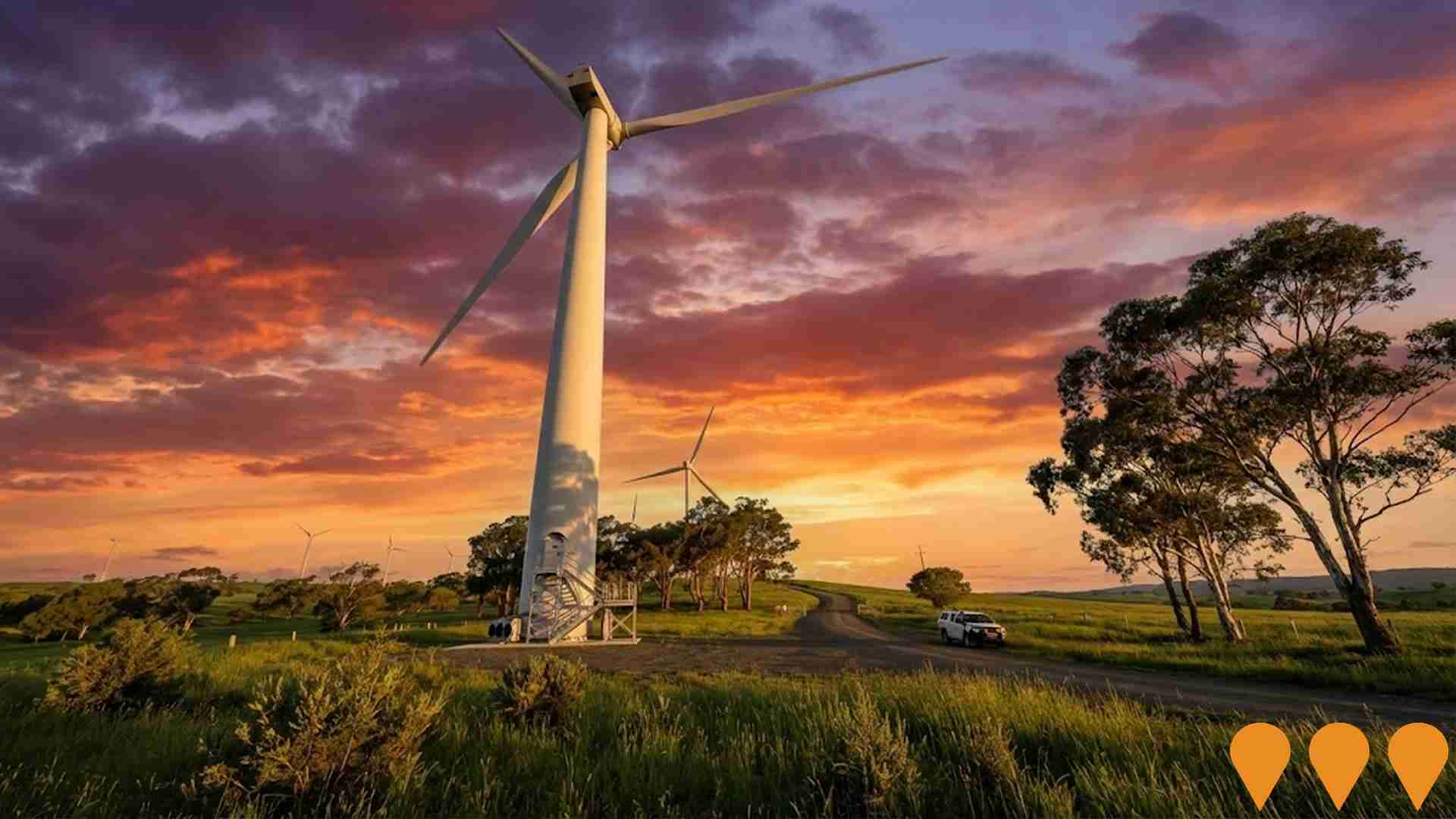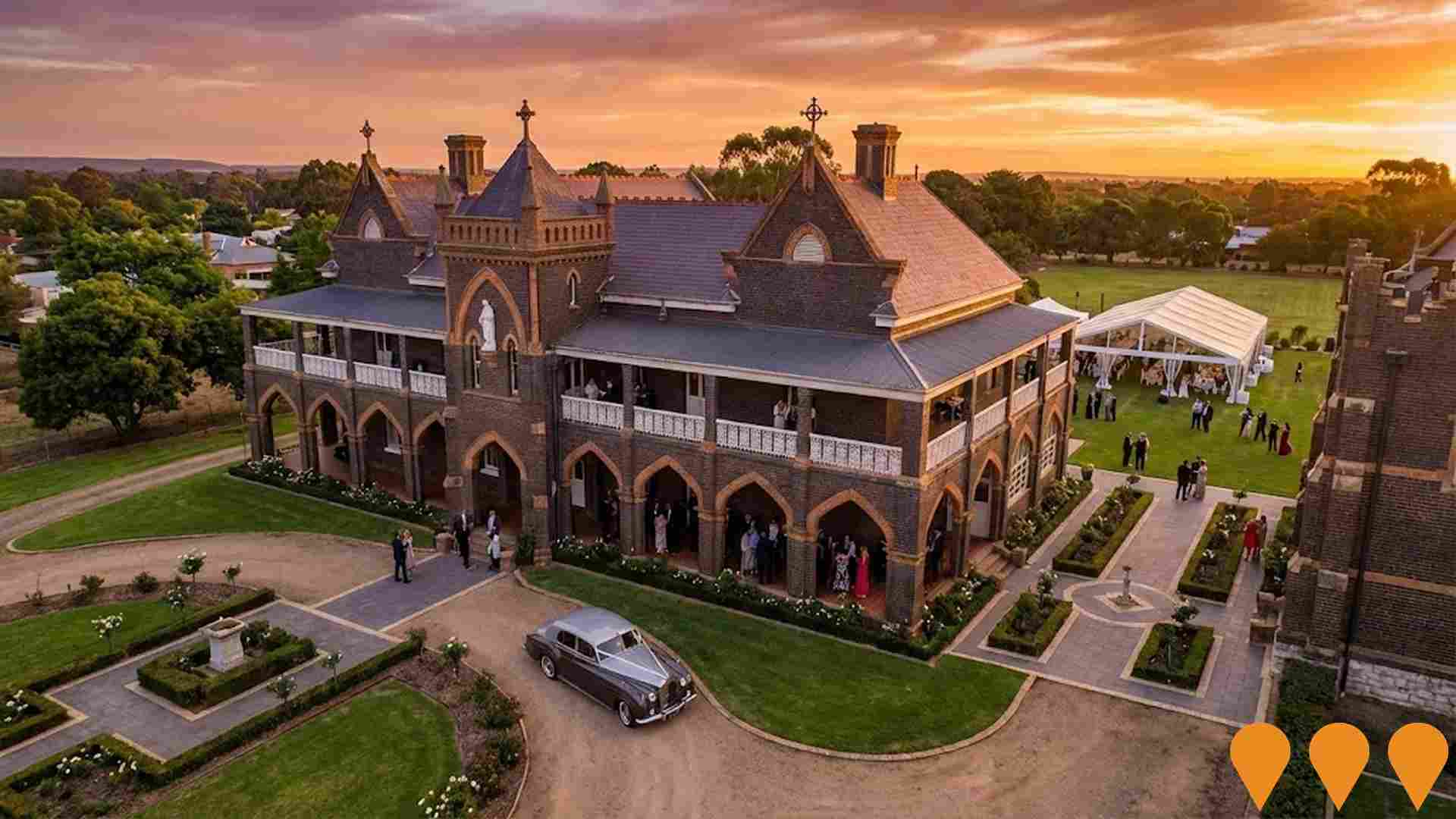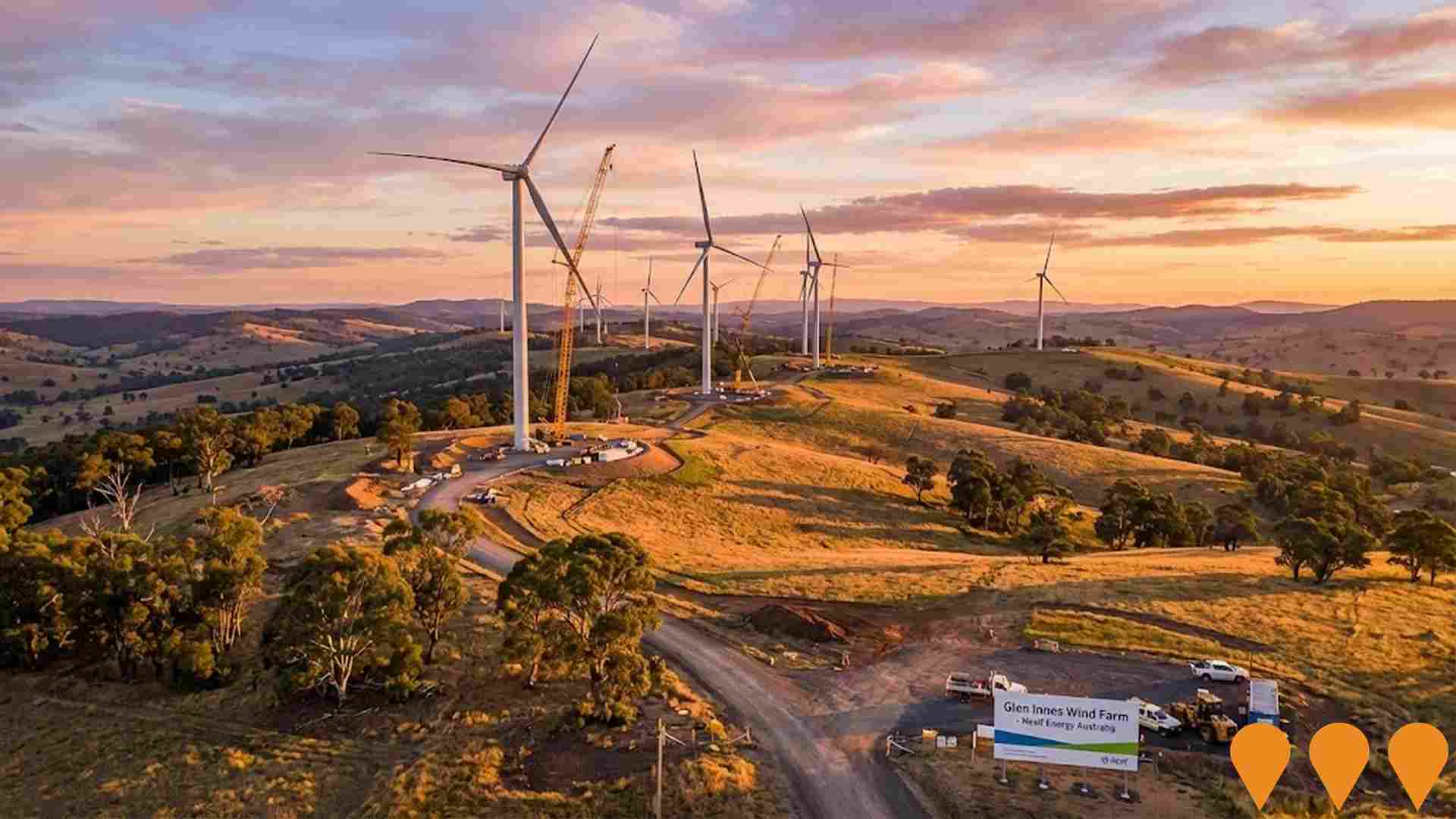Chart Color Schemes
est. as @ -- *
ABS ERP | -- people | --
2021 Census | -- people
Sales Activity
Curious about local property values? Filter the chart to assess the volume and appreciation (including resales) trends and regional comparisons, or scroll to the map below view this information at an individual property level.
Find a Recent Sale
Sales Detail
Population
Glen Innes is positioned among the lower quartile of areas assessed nationally for population growth based on AreaSearch's assessment of recent, and medium term trends
Glen Innes's population is approximately 9,178 as of August 2025. This figure represents an increase of 247 people since the 2021 Census, which reported a population of 8,931. The change is inferred from the estimated resident population of 8,987 in June 2024 and an additional 51 validated new addresses since the Census date. This results in a population density ratio of 1.7 persons per square kilometer. Glen Innes's growth rate of 2.8% since the 2021 census exceeded that of the SA3 area at 2.7%, indicating it as a growth leader in the region. Interstate migration contributed approximately 66.0% of overall population gains during recent periods, driving this growth.
AreaSearch uses ABS/Geoscience Australia projections for each SA2 area, released in 2024 with a base year of 2022, and NSW State Government's SA2 level projections where necessary, released in 2022 with a base year of 2021. Growth rates by age group are applied to all areas from these aggregations for the years 2032 to 2041. By 2041, the area is anticipated to increase by 61 persons based on the latest population numbers, showing a decrease of 1.5% in total over the 17-year period.
Frequently Asked Questions - Population
Development
AreaSearch assessment of residential development drivers sees a low level of activity in Glen Innes, placing the area among the bottom 25% of areas assessed nationally
Glen Innes has granted approximately 15 residential properties approval annually. Over the past five financial years, from FY21 to FY25, 78 homes were approved, with one more approved so far in FY26. On average, about 0.4 new residents per year have arrived for each new home during these five years, indicating that supply is meeting or exceeding demand and providing ample buyer options while allowing for population growth beyond current forecasts.
The average expected construction cost value of new dwellings in Glen Innes is $422,000, which aligns with regional trends. This financial year has seen $7.9 million in commercial approvals registered, suggesting the area's residential character. Comparatively, Glen Innes has around two-thirds the rate of new dwelling approvals per person compared to the Rest of NSW. Nationally, it ranks at the 28th percentile for areas assessed, implying somewhat limited buyer options while strengthening demand for established dwellings.
This is below the national average, indicating the area's established nature and suggesting potential planning limitations. Recent construction in Glen Innes comprises 83.0% standalone homes and 17.0% medium to high-density housing, maintaining its traditional low-density character with a focus on family homes that appeal to those seeking space. The estimated population per dwelling approval is 645 people, reflecting the area's quiet, low-activity development environment. Population projections indicate stability or decline in Glen Innes, which should result in reduced housing demand pressures and benefit potential buyers.
Frequently Asked Questions - Development
Infrastructure
Glen Innes has moderate levels of nearby infrastructure activity, ranking in the 46thth percentile nationally
AreaSearch has identified 21 projects that could impact the area, with key ones being Glen Innes Hospital Redevelopment, Glen Innes Battery Energy Storage System, New England Highway Safety Upgrades, and St Joseph's Convent Function Centre (Glen Innes). The following list details those likely to be most relevant.
Professional plan users can use the search below to filter and access additional projects.
INFRASTRUCTURE SEARCH
 Denotes AI-based impression for illustrative purposes only, not to be taken as definitive under any circumstances. Please follow links and conduct other investigations from the project's source for actual imagery. Developers and project owners wishing us to use original imagery please Contact Us and we will do so.
Denotes AI-based impression for illustrative purposes only, not to be taken as definitive under any circumstances. Please follow links and conduct other investigations from the project's source for actual imagery. Developers and project owners wishing us to use original imagery please Contact Us and we will do so.
Frequently Asked Questions - Infrastructure
Glen Innes Hospital Redevelopment
A $200 million Stage 1 redevelopment of Glen Innes District Hospital delivering a new clinical services building with expanded emergency department, medical imaging, operating theatres, birthing suite, inpatient unit, ambulatory care, mortuary, ambulance bay and helipad. The project integrates with existing facilities and includes significant upgrades to clinical capacity for the New England region.

White Rock Wind Farm
Multi-stage wind farm development with Stage 1 (70 turbines, 175MW) operational and Stage 2 (up to 48 additional turbines, 216MW) in planning. Total capacity up to 391MW serving approximately 235,000 homes annually.

St Joseph's Convent Function Centre (Glen Innes)
Heritage-listed former St Joseph's Convent with a current Development Approval from Glen Innes Severn Council to convert to a function and wedding venue with around 23 guest suites plus reception, dining and offices. The property is presently being marketed for sale, with past partial use as guest accommodation. Redevelopment timing will depend on new ownership and delivery of the approved works.

Glen Innes Severn Housing Strategy 2022-2041
Council-adopted strategy to increase housing supply, diversity and affordability across the Glen Innes Severn LGA through 2041. It guides rezonings, infrastructure sequencing and partnerships with NSW agencies, community housing providers and developers.

Glen Innes Severn Local Strategic Planning Statement
The Local Strategic Planning Statement (LSPS) plans for the Glen Innes Severn community's economic, social and environmental land use needs over the next 20 years.

Glen Innes Highlands Skywalk
An 80-metre elevated boardwalk with three viewing platforms offering spectacular views over Glen Innes township and Northern Tablelands. Features Celtic and Ngarabul cultural connections with 22 audio stories and 360-degree drone footage accessible via QR code technology.

Glen Innes Powerhouse Museum Redevelopment
Proposed redevelopment of the former Glen Innes Power Station into a state-of-the-art museum in partnership with Sydney Powerhouse Museum. Concept proposal and business case in development to create a nationally significant cultural heritage attraction.

Youth and Sporting Precinct Upgrades and Connectivity
The project involves the redevelopment of the existing skate park, combining old and new elements for skaters of all skill levels, and the construction of shared pathways connecting the Sports Precinct to Taylor Street and local schools in Glen Innes.

Employment
The employment environment in Glen Innes shows above-average strength when compared nationally
Glen Innes has a balanced workforce with both white and blue collar jobs. Key sectors include agriculture, forestry & fishing, health care & social assistance, and retail trade.
As of June 2025, the unemployment rate is 2.9%. Employment growth over the past year is estimated at 4.3%. There are 4,353 residents in work, with an unemployment rate 0.7% lower than Rest of NSW's 3.7%. Workforce participation lags at 47.1%, compared to Rest of NSW's 56.4%.
The area shows strong specialization in agriculture, forestry & fishing, with employment share 3.6 times the regional level. Construction has limited presence, at 6.2% compared to 9.7% regionally. Employment opportunities locally appear limited, as indicated by Census working population vs resident population count. Over a 12-month period ending June 2025, employment increased by 4.3%, labour force by 3.3%, reducing unemployment by 0.9 percentage points. In contrast, Rest of NSW saw employment fall by 0.1%, labour force expand by 0.3%, and unemployment rise by 0.4 percentage points. National employment forecasts from Jobs and Skills Australia (May 2025) project growth of 6.6% over five years and 13.7% over ten years. Applying these projections to Glen Innes's employment mix suggests local growth of approximately 5.6% over five years and 12.1% over ten years.
Frequently Asked Questions - Employment
Income
Income metrics place the area in the bottom 10% of locations nationally according to AreaSearch analysis
AreaSearch's latest postcode level ATO data for financial year 2022 shows Glen Innes had a median income among taxpayers of $37,391 and an average of $45,254. This was below the national average. Rest of NSW had a median income of $49,459 and an average of $62,998 during the same period. Based on Wage Price Index growth of 12.61% since financial year 2022, current estimates for Glen Innes would be approximately $42,106 (median) and $50,961 (average) as of September 2025. Census data reveals household, family and personal incomes in Glen Innes all fall between the 2nd and 5th percentiles nationally. Income brackets indicate 32.3% of the population (2,964 individuals) fall within the $400 - $799 income range, differing from metropolitan regions where the $1,500 - $2,999 category is predominant at 29.9%. The concentration of 43.7% in sub-$800 weekly brackets highlights economic challenges faced by a significant portion of the community. While housing costs are modest with 87.0% of income retained, total disposable income ranks at just the 4th percentile nationally.
Frequently Asked Questions - Income
Housing
Glen Innes is characterized by a predominantly suburban housing profile, with above-average rates of outright home ownership
Glen Innes' dwelling structure, as per the latest Census, consisted of 92.6% houses and 7.4% other dwellings. This compares to Non-Metro NSW's 93.0% houses and 6.9% other dwellings. Home ownership in Glen Innes was 48.5%, with mortgaged dwellings at 25.7% and rented ones at 25.8%. The median monthly mortgage repayment was $1,083, below Non-Metro NSW's average of $1,100. Median weekly rent in Glen Innes was $220, compared to Non-Metro NSW's $240. Nationally, Glen Innes' mortgage repayments were significantly lower than the Australian average of $1,863, and rents substantially below the national figure of $375.
Frequently Asked Questions - Housing
Household Composition
Glen Innes features high concentrations of lone person households, with a lower-than-average median household size
Family households comprise 61.8% of all households, including 18.2% couples with children, 31.8% couples without children, and 10.8% single parent families. Non-family households account for 38.2%, with lone person households at 35.6% and group households at 2.7%. The median household size is 2.1 people, which is smaller than the Rest of NSW average of 2.3.
Frequently Asked Questions - Households
Local Schools & Education
Glen Innes faces educational challenges, with performance metrics placing it in the bottom quartile of areas assessed nationally
The area has lower university qualification rates at 15.2% compared to the NSW average of 32.2%. Bachelor degrees are most common at 11.3%, followed by graduate diplomas (2.0%) and postgraduate qualifications (1.9%). Vocational credentials are held by 41.4% of residents aged 15+, with advanced diplomas at 9.7% and certificates at 31.7%. Educational participation is high, with 28.9% of residents currently enrolled in formal education.
This includes primary (11.5%), secondary (8.8%), and tertiary (2.3%) education. Glen Innes has a network of 8 schools educating approximately 1,134 students, comprising 6 primary, 1 secondary, and 1 K-12 school.
Frequently Asked Questions - Education
Schools Detail
Nearby Services & Amenities
Transport
Transport servicing is low compared to other areas nationally based on assessment of service frequency, route connectivity and accessibility
Glen Innes has 431 active public transport stops offering a mix of train and bus services. These are served by 27 routes that collectively facilitate 261 weekly passenger trips. The area's transport accessibility is rated as good, with residents typically located 276 meters from the nearest stop.
Service frequency averages 37 trips per day across all routes, equating to approximately 0 weekly trips per individual stop.
Frequently Asked Questions - Transport
Transport Stops Detail
Health
Health performance in Glen Innes is a key challenge with a range of health conditions having marked impacts on both younger and older age cohorts
Glen Innes faces significant health challenges, with various conditions affecting both younger and older age groups. Private health cover is low at approximately 47% (~4,276 people), compared to the national average of 55.3%.
The most prevalent medical conditions are arthritis (12.1%) and mental health issues (9.7%). While 58.6% report no medical ailments, this is lower than the Rest of NSW's 61.0%. Glen Innes has a higher proportion of residents aged 65 and over at 30.1% (2,762 people), compared to Rest of NSW's 27.4%.
Frequently Asked Questions - Health
Cultural Diversity
The latest Census data sees Glen Innes placing among the least culturally diverse areas in the country when compared across a range of language and cultural background related metrics
Glen Innes had a cultural diversity index below the average, with 86.7% of its population being citizens, 91.6% born in Australia, and 97.4% speaking English only at home. Christianity was the predominant religion, comprising 64.4% of Glen Innes' population, compared to 64.8% across Rest of NSW. The top three ancestry groups were English (32.9%), Australian (31.9%), and Scottish (9.3%).
Notably, Australian Aboriginal (5.2%) was overrepresented in Glen Innes compared to the regional average of 6.4%. German (3.9%) and Irish (9.1%) also showed notable representation, matching or slightly exceeding their respective regional averages of 3.9% and 8.7%.
Frequently Asked Questions - Diversity
Age
Glen Innes ranks among the oldest 10% of areas nationwide
Glen Innes has a median age of 50, which is higher than Rest of NSW's figure of 43 and well above the national average of 38. The percentage of people aged 65-74 in Glen Innes is 15.8%, compared to Rest of NSW's percentage, while the 35-44 age group is less prevalent at 8.6%. This 65-74 concentration is higher than the national figure of 9.4%. According to the 2021 Census, the 75 to 84 age group has increased from 9.6% to 10.6%, while the 45 to 54 cohort has declined from 12.0% to 10.8% and the 55 to 64 group has dropped from 15.9% to 14.9%. Demographic modeling indicates that Glen Innes's age profile will significantly change by 2041. The 85+ age cohort is projected to increase markedly, with an expansion of 258 people (76%) from 337 to 596. Notably, the combined 65+ age groups will account for 88% of total population growth, reflecting the area's aging demographic profile. Conversely, population declines are projected for the 5-14 and 45-54 cohorts.



